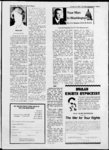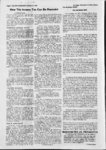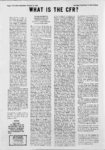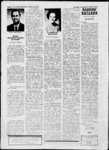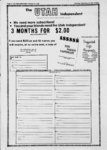| OCR Text |
Show The Paper That Dares To Take A Stand ANALYSIS COUNCIL FOR REVOLUTION Thomas Jefferson mittee with House were such young intellectuals as Walter Lippmann, Norman Thomas, Allen Dulles, John Foster Dulles, and Christian Herter. Their labors resulted in the League of Nations Covenant. Colonel House apparently felt that the frustration and disruption created by World War I had sufficiently conditioned the American people that they could be enticed into backing the League of Nations as a means of avoiding future wars. But these plans ran into serious difficulty beginning with President Wilsons attendance at the Paris Peace Conference, and later, due in large part to alert Constitutionalists in the UJS. Senate. It soon became clear that the United States would not support the League of Nations. Despite their bitterness and disappointment at the prospect of the of other nations. And a simultaneous effort has been made to transfer the once observed that Single acts of tyranny may be ascribed to the accidental opinion of a day; but a series of oppressions, begun at a distinguished period, and pursued unalterably through every change of ministers,' too plainly prove a delib-- ; erate, systematical plan of reducing ua v , to slavery. (The Works Of Thomas Jefferson, Volume 1, Page 130.) On December 9, 1969, President Nixon met with David Rockefeller,. Robert Anderson, and John J. McCloy for a discussion of foreign policy matters. The latter three are all mem-- '' bers of an organization known as the Leagues rejection by the Senate, Council on Foreign Relations (C.F.R.).' . Colonel House and a group of his most PresiOn December 11, 1969, the , dedicated followers immediately dent met with! General Lucius Clay, . mapped plans to reverse the defeat. On Dean Acheson, and Thomas Dewey for May 30, 1919, they met with a group a discussion of foreign policy matters. of Englishmen at the MaAgain, all three are members of the jestic Hotel in Paris, where they agreed semi-secrC.F.R. same elite, . to form an organization for the study President Nixon was himself a of international affairs. The American ' member of the Council on Foreign group came home and formed the Relations for a short time during the . Council on Foreign Relations, which was incorporated in 1921. The purSixties, and as late as October of 1967 article C.F.R.s for the he authored an pose of the new organization was to influential Foreign Affairs magazine. change American foreign policy to fit In 19S2 and again in 1956, Mr. the designs for world government envisioned by its leaders, and at the same Nixon ran on the Republican Presimember C.F.R. dential tickets with time to condition the American people twice to defeating Dwight Eisenhower, accept these changes as both wise and necessary. the Democrats nominee C.F.R. member Adlai Stevenson. During the Eisen-- In 1927, the great tax-fre- e foundahower years, our nation's foreign . tions began pouring money into the policy was administered by Secretaries Council, thus enabling it to greatly Chrisand of State John Foster Dulles expand its activities and influence. mem-: were both of whom tian Herter, In 1941, the State Department bers of the C?F.R. created a Division of Special Research, J . .In 1960 J Mr! Nixon chose as his ' with Led Pasvolsky as Director. Pasvol- Presidential running mate C.F.R. mem-V- " sky was' a member of. the C.F.R., and lost blit that Cabot ber Henry. Lodge, other C.F.R. members' were soon canDemocrat election the to years brought in until they completely domC.F.R. member John didate, one-tim- e inated the new division. F. Kennedy, who promptly appointed In 1942, when the State DepartC.F.R. member Dean Rusk as Secrement set-u- p the Advisory Committee State. of tary on Postwar Foreign Policy, the Vice In 1968, Mr. Nixons Democrat Chairman, Executive Officer, and at was race Presidential opponent in. the least fjve other members of the ComHubert member C.F.R. Humphrey, mittee came from the ranks of the and following his close victory he, Council on Foreign Relations. A. member C.F.R. Henry appointed And in 1945, when the United Kissinger as his chief advisor on Nations Organizing Conference was foreign policy. held in San Francisco, over forty It is surprising to many Americans members of the U.S. delegation were to learn that such a relatively unalso members of the Council on Forknown organization as the Council on eign Relations, including Conference has been exercising Foreign Relations Secretary General Alger Hiss, who was such great influence in our nation later convicted for lying about his The most trusted and powerful activities as a Soviet spy. Some of the advisor to President Woodrow Wilson, others in the delegation were: Secreas readily acknowledged in historical tary of State Edward Stettinius, John studies written by some of Wilsons Foster Dulles, John J. McCloy, Nelson A. Rockefeller, Adlai Stevenson, and great admirers, was Colonel Edward M. behind-the-scenHouse. Colonel House was a Ralph Bunche. had who enormous This time, the effects of war and operator influence in shaping Wilsons domestic long years of propaganda and condiand foreign policies, selecting Cabinet tioning did the job. The U.S. Senate members and other major appointees, ratified the United Nations Charter, and running the Wilson State Departand the United States officially became part of the nucleus for a world ment. In September, 1916, President Wilsocialist government. , Since that time, the main efforts of son appointed Colonel House to head a committee whose assignment inkey C.F.R. members have been directed toward socializing Americas econocluded, among other things, the draftmy and, largely through the use of ing of a charter for world government. American foreign aid, the economies Among those who served on the com . -- r October 19, 1978 The Utah Independent' Page loyalties of the American people from the United States to the United Nations and related international agencies. Thus, the footprints of the C.F.R. can be traced through nearly every major incident that has contributed to a destruction of American stability and sovereignty, from the creation of fiscal and revolutionary chaos here at home to the conduct of no-wi- n wars abroad. The resulting disruption, demoralization, and hopelessness is being used to convince a growing number of Americans that our traditional institutions and form of government are inadequate for our present needs, and must therefore be discarded and replaced with the controls and regulations of the new order envisioned by the Insiders who intend to run that Hew order. a) . like-mind- et ed . . . . " . -- es On December 29, 1969, Congressman John R. Rarick entered into the Congressional Record a current (as. of September 8, 1969) membership roster of the Council on Foreign Relations. Using that list as a guide, here are just some of the C.F.R. members appointed or retained by President Richard Nixon since the 1968 election: Dr. George P. Baker, Advisory Council on Executive Organization; George W. Ball, foreign policy consultant to the State Department; Jacob. D. Beam,' Ambassador to the Soviet Union; Lt. Gen. Donald V. Bennett, Director of the Defense Intelligence Agency; C. Fred Bergsten, Operations Staff of the National Security Council; Dr. Harold Brown, GeneralAdvisory Committee' of the U.S. Arms Control and Disarmament - Agency, and senior 'member-othe U.S. delegation for talks with the Soviet Union on strategic arms limitations (S.A.L.T.); William' B. Buffura, Deputy Representative to the United Nations; Ellsworth Bunker, Ambassador to South Vietnam; Dr. Arthur F. Bums, Counsellor to the President (scheduled to become Chairman of the Federal Reserve Board in February, succeeding C.F.R. member William McChesney Martin); Henry A. Byroade, Ambassador to the Philippines; Harlan Cleveland, Ambassador to N.A.T.O.; Richard N. Cooper, Operations Staff of the National Security Council; Philip K. Crowe, Ambassador to Norway; William B. Dale, Executive Director of the International Monetary Fund; C. Douglas Dillon, General Advisory Committee of the U.S. Arms Control and Disarmament -- f Agency; Harvey S. Firestone Jr., Chairman of the Board of Governors, United Service Organization, Inc.; William C. Foster, General Advisory Committee of the U.S. Arms Control and Disarmament Agency; Thomas S. Gates, Chairman, Commission Armed on an Force; Carl J. Gilbert, Special Representative for Trade Negotiations; Gen. Andrew J. Good-All-Volunte- er . I : . paster. Supreme Allied Commander in Europe (succeeding C.F.R. member Gen. Lyman Lemnitzer); Kermit Gordon, General Advisory Committee of the U.S. Arms Control and Disarmament Agency; Joseph Adolph Greenwald, U.S. Representative to the Organization for and Economic Cooperation Development; Gen. Alfred M. Gruenther, Commission on an All-- Volunteer Armed Force; Morton Halperin, Operations Staff of the National Security Council; Rev. Theodore Martin Hesburgh, Chairman of the U.S. Commission on Civil Rights, and member of the Commission on an Armed Force; C. Ambassador to Robert Hill, Spain; Samuel P. Huntington, Task Force on International Development; John N. Irwin II, special emissary to discuss current U.S. relations with Peru; All-Volunte- er Joseph E. Johnson, Alternate Representative to the 24th Ses-- sion of the General Assembly of the United Nations; Janies R. Killian, General Advisory Committee of the U.S. Arms Control and Disarmament Agency; Henry A. Kissinger, Assistant to the President for National Security Affairs; Gen. George A. Lincoln, Director of the Office of Emergency Preparedness; Henry Cabot Lodge, chief negotiator at the Paris peace talks; Henry Loomis, Deputy Director of the United States Information Agency; Douglas MacArthur II, Ambassador to Iran; John J. McCloy, Chairman, General Advisory Committee of the U.S. Arms Control and Disarmament Agency; Paul W. McCracken, Chairman of the Council of Economic Advisers; Edward S. Mason, Task Force on International Development; Charles A. Meyer, Assistant Secretary of State; Robert D. Murphy, Special Consultant on International Affairs; Paul H. Nitze, senior member, U.S. delegation for talks with the Soviet Union on strategic arms limitations (S.A.L.T.); Gen. Lauris Norstad, Commission on an Armed Force, and General Advisory Committee of the U.S. Arms Control and Disarmament Agency; Roderic L. OConnor, Assistant Administrator for East Asia of the Agency for International Development; Robert E. Osgood, Operations Staff of the National Security Council; Richard F. Pedersen, Counselor of the State Department; John R. Petty, Assistant Secretary of the Treasury for International Affairs; Christopher H. Phillips, Deputy Representative in the U.N. Security Council; Alan Pifer, consultant to the President on educational finance; Isidor I. to the Rabi, consultant-at-larg- e President's Science Advisory Committee; Stanley R. Resor, Secretary of the Army; Elliot L. Richardson, Undersecretary of State; John Richardson Jr., on page 6 All-Volunte- er 5 |



